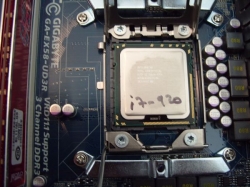A Closer Look:
The i7 is a major design change for Intel; so major that they needed to create a new socket to accommodate it. The new socket has 1366 pins as opposed to the 775 of prior processors.
A Page From The Enemy:
Since the dawn of the NetBurst architecture and continuing on into the Core2 line, Intel has always featured a memory controller separate from the actual processor. No longer is this the case. With the creation of the new i7 line, Intel has decided to copy a page from AMD’s book and integrate the memory controller onto the chip. This action alone is one of the key design changes that set the i7 apart from all prior Intel chips. The first incarnation of the i7 ships with a triple-channel DDR3 memory controller, which means that RAM modules will need to be installed in groups of three in order to fully utilize memory bandwidth. With this decision to integrate the memory controller, Intel needed a way for the cores to quickly communicate with the rest of the hardware. The Intel QuickPath Interconnect or QPI is what came out of this. The QPI for the i7 is essentially what HyperTransport has been for AMD chips. It replaces the FSB and offers a high speed channel to communicate with all of the I/O devices.
The Return Of An Old Trick:
Following the new power efficiency model that was adopted for the creation of the Atom (designers may add a new feature to a chip if it yields a 1% increase in performance for at most a 1% increase in power consumption), Intel decided that it was worth the power to efficiency cost to bring back Hyper-Threading for their new line of chips. This means that the first wave release of i7 chips that feature 4 actual cores will be seen by the operating system as 8 logical cores. As to whether or not there is a market for consumer level 8 core processing is debatable, but the fact that the chip is scaling towards the future of parallel computing is quite comforting.


When we test hardware, we try to do everything that we can to make the bottleneck of the rig that piece of hardware. In this review, the reviewer was using 2 – 4870’s in Crossfire. This gives a fairly good benchmark point for what you will expect to see.
I find all the game benches to be lacking in comparative data. All we find out is where your rig gives out of being playable, not how much a difference the 920 is doing. It could very well be that you are reaching the capacity of what the graphics card is able to display and that the CPU isn’t involved much at all.
Nice! I need this information. But could you tell me what the “PCG 08” means?
PCG is a processor power specification to help identify thermal solutions, power supplies, and chassis that will meet specific power requirements. The PCG mark can be found on the box label and engraved on the IHS of the processor.
Great Blogging!!
Keep Your Good Work Going!!
Pretty cool post. I just came across your site and wanted to say
that I’ve really liked reading your blog posts. Any way
I’ll be subscribing to your feed and I hope you post again soon!
Hey, nice post, very well written. You should post more about this.